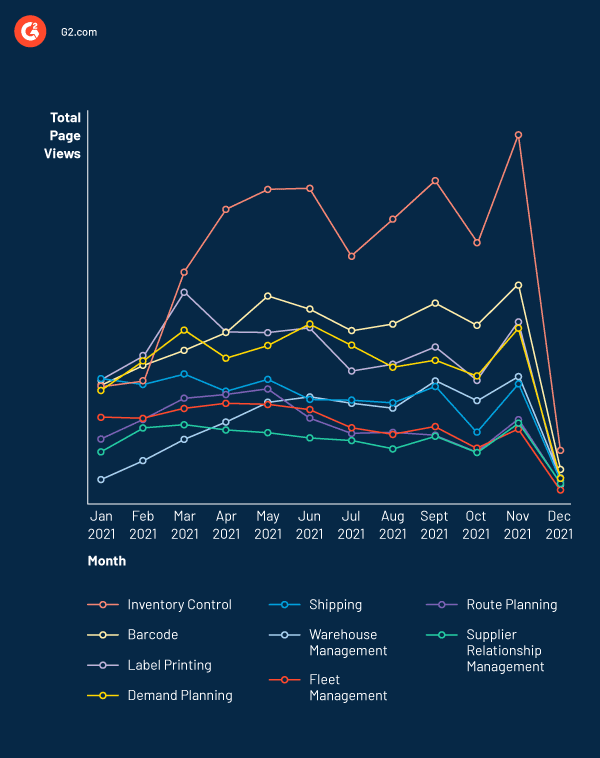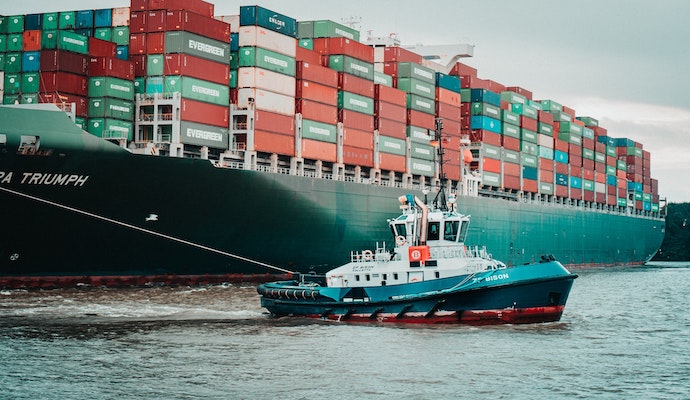This post is part of G2's 2022 digital trends series. Read more about G2’s perspective on digital transformation trends in an introduction from Tom Pringle, VP, market research, and additional coverage on trends identified by G2’s analysts.
Resilience and e-commerce integration are the names of the game
2022 TRENDS PREDICTION
The new focus of operating the supply chain will be on building a system that withstands future conflicts.
The shock to the system created by COVID-19 has stressed the modern supply chain. Over the past two years, consumers have seen empty shelves and frequent sellouts. Although consumer purchasing power greatly waned during waves of unemployment, it has experienced a significant resurge. Despite the boom in consumer demand, the supply chain has failed to keep up. Category traffic data from G2 confirms this struggle, with inventory management software surging with visitors seeking new solutions to these problems.
Recent events have tested the global supply chain and pushed it past its breaking point. As a result, logistics professionals are completely rethinking how to develop a disaster-proof supply chain that keeps shelves stocked and accommodates the growing importance of e-commerce. G2 data emphasizes this trend and the shift in thinking it is bringing, as engagement with inventory management and e-commerce software tools has grown throughout 2021.
More so than ever, customers rely on e-commerce to meet their needs. What first began as a response to health and safety concerns has become the essence of convenience and efficiency for busy individuals. Although online shopping was a force to be reckoned with before the COVID-19 pandemic, the transformation into an omnichannel economy means e-commerce software is growing but not dominating the supply chain and logistics software category. User data from G2 on category traffic mirrors this reality as well.
The sputtering of the supply chain represents the difficulty the system is encountering to function in this new normal. Working with and investing in this new normal is key to avoiding indefinite dysfunction.
| Related: Supply Chain on the Verge of Collapse Ahead of the Holiday Season → |
Want to learn more about Supply Chain & Logistics Software? Explore Supply Chain & Logistics products.
Software with AI and automation features will be desirable
2022 TRENDS PREDICTION
Supply chain professionals will invest in software that collect real-time data and utilize artificial intelligence to improve resiliency. Reshoring of jobs and relocation of labor toward neighboring countries will occur.
COVID-19’s seismic shock to the supply chain exposed vulnerabilities in the system. As a result, a new way of operating that guarantees durability will define the next chapter in the logistics business. Based on lessons learned since March 2020, we can expect to see the growth in automation, AI and machine learning, reshoring of jobs, and a reliance on suppliers closer to home and outside of China.
Software with automation and artificial intelligence will help ease the friction that outdated facilities and operating procedures create. Some demand planning software, for example, uses machine learning to collect massive amounts of information from multiple sources to develop better forecasts for future consumer demand. Through these features, vendors can prepare the supply chain well in advance to prevent the mass sellouts currently seen on store shelves.
Furthermore, although the United States is a country reliant on imports, geopolitical tension and climate change have created a need for diversifying suppliers and reshoring labor and manufacturing. For example, recent international trade disputes exacerbated the COVID-19 pandemic’s already devastating impact on supply chains. Many companies are diversifying suppliers to include other countries in the Asia-Pacific region, such as Thailand, to tackle these issues.
Many American companies are also moving jobs to the United States, Mexico, and other Central American countries. This shift has occurred because companies are searching for affordable labor while simultaneously leveraging established relationships with countries close to home.
Omnichannel shopping will be the new normal
2022 TRENDS PREDICTION
The supply chain will be redesigned to accommodate both in-store experiences and high volumes of online shopping. Last-mile delivery tools will lead the way in making this trend a long-lasting reality.
It’s no secret that the internet has fundamentally changed the way shoppers make purchases today. However, shelter-in-place orders created a “homebody economy” that caused many to convert into online shoppers. Overall, we’ve seen a 30% increase in online penetration since March 2020. Headlines suggesting the total death of brick-and-mortar stores are overstated, but omnichannel shopping is set to become the new normal.
The growth of dual in-person and digital shopping experiences means the supply chain will need to revitalize existing processes. As it currently stands, many e-commerce and supply chain/logistics software are distinct, but that line should blur over time.
Demonstrating this trend is an emerging category on G2 in the logistics space called cross border e-commerce software. Although it is a more tenured product, last mile delivery software also bridges the e-commerce and supply chain categories by managing online orders’ delivery process.
While these new supply chain tools are designed to support the growth of e-commerce, they are not the current leaders in terms of scale. According to G2 data from December 8, 2021, last mile delivery tools and cross-border e-commerce category pages ranked 1st (13.9%) and 5th (8.3%), respectively, for growth in website visitors, but 10th and 20th in the overall volume of visitors in supply chain categories.
Demand for inventory management tools will rise
2022 TRENDS PREDICTION
Inventory management solutions (particularly inventory control) will be market leaders for software systems that help manage the supply chain.
Inventory control software, barcode software, and label printing software collectively comprise the inventory management category. Expect these systems to be the leaders in supply chain automation tools because together, they prevent overstocking and trigger restocking when inventory levels are low.
According to G2 data from December 8, 2021, inventory control, barcode, and label printing drew the most category traffic in the supply chain category throughout 2021. In addition, demand planning software (which helps predict future consumer demand and thus plan inventory levels) ranked fourth.

Final thoughts
The risk-averse nature of the supply chain means fundamental changes seen in other industries in response to the pandemic are unlikely to happen in the logistics business. Instead of expecting a revolution, plan for a deliberate upgrade and recalibration.

Anthony Orso
Anthony is a Market Research Analyst specializing in supply chain and logistics, as well as data science applications in the industry. Prior to joining G2, Anthony worked in the research and strategy department of advertising. When Anthony isn't studying for his master's program in data science, he enjoys film criticism, true crime, and playing classical music on his violin.
